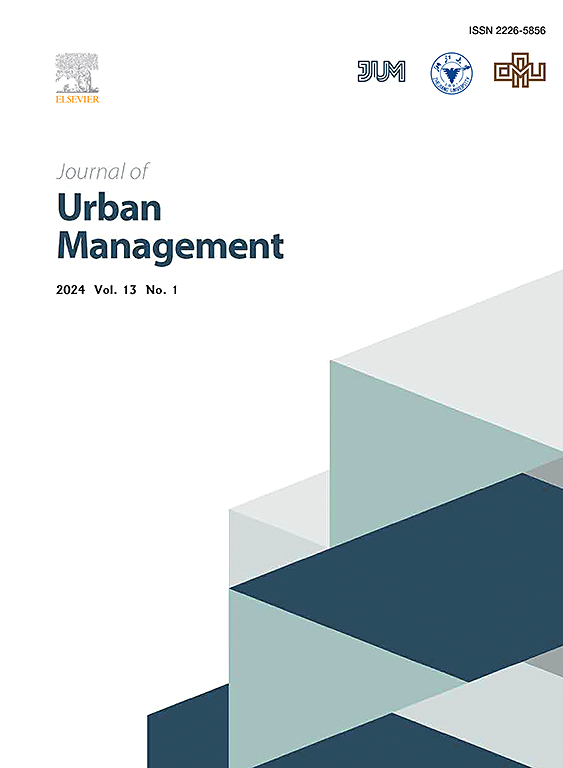Integrating resilience and vulnerability components in assessing urbanization impacts on farming household livelihood strategies: Insights from Ethiopia
IF 5
2区 社会学
Q1 URBAN STUDIES
引用次数: 0
Abstract
Integrating resilience and vulnerability components is critical in understanding urbanization impacts on farming household livelihood strategies. This study aims to combine methods and concepts of resilience and vulnerability, that are independently analyzed by previous research to grasp urbanization impacts on farming households. A cross-sectional survey was conducted using a randomly recruited 300 farming households from 4 kebeles to obtain quantitative data. Qualitative data were collected from 30 key informants and 4 group discussions to complement quantitative data. Principal component analysis was employed to identify unrelated factors. Tobit models were applied to estimate strategy-related income that determines household strategy choices. Additionally, linear regression models were utilized to determine factors affecting household resilience and vulnerability index. Results show that farming was the main livelihood strategy in peri-urban despite low earnings. The off-farm strategy was the highest in household income contribution although participants were low. On-farm and off-farm strategies have a greater resilience-vulnerability index to urbanization when compared to farm and non-farm strategies. Urbanization has heterogeneous effects on peri-urban household livelihood strategies due to variations in capital assets, self-organization, learning ability, sensitivity, exposure, and adaptability. Based on these findings, policies should highlight the heterogeneous effects of urbanization and be tailored to the specific needs of different clusters to enhance their resilience and reduce vulnerability to farmland loss. Implementing these measures will aid governments in improving livelihood strategies in peri-urban areas, alleviating poverty, and mitigating food insecurity. Ultimately, such actions will contribute to inclusive and sustainable urban growth amidst rapid urbanization.

在评估城市化对农户生计战略的影响时整合复原力和脆弱性要素:来自埃塞俄比亚的见解
整合复原力和脆弱性要素对于理解城市化对农户生计战略的影响至关重要。本研究旨在结合以往研究中独立分析的复原力和脆弱性的方法和概念,把握城市化对农户的影响。本研究采用横断面调查方法,随机抽取4个省300户农户进行调查,获得定量数据。定性数据收集自30名关键举报人和4次小组讨论,以补充定量数据。采用主成分分析确定不相关因素。Tobit模型被用来估计决定家庭战略选择的与战略相关的收入。此外,利用线性回归模型确定家庭恢复力和脆弱性指数的影响因素。结果表明,尽管农业收入较低,但农业是城郊地区的主要生计策略。非农战略在家庭收入贡献中是最高的,尽管参与者的比例很低。与农业和非农业战略相比,农业和非农战略对城市化具有更高的恢复脆弱性指数。由于资本资产、自组织、学习能力、敏感性、暴露度和适应性的差异,城市化对城市周边家庭生计策略具有异质性影响。基于这些发现,政策应突出城市化的异质性效应,并根据不同集群的具体需求进行调整,以增强其抵御能力,减少对耕地流失的脆弱性。实施这些措施将有助于各国政府改善城郊地区的生计战略,减轻贫困和粮食不安全。最终,这些行动将有助于在快速城市化中实现包容性和可持续的城市增长。
本文章由计算机程序翻译,如有差异,请以英文原文为准。
求助全文
约1分钟内获得全文
求助全文
来源期刊

Journal of Urban Management
URBAN STUDIES-
CiteScore
9.50
自引率
4.90%
发文量
45
审稿时长
65 days
期刊介绍:
Journal of Urban Management (JUM) is the Official Journal of Zhejiang University and the Chinese Association of Urban Management, an international, peer-reviewed open access journal covering planning, administering, regulating, and governing urban complexity.
JUM has its two-fold aims set to integrate the studies across fields in urban planning and management, as well as to provide a more holistic perspective on problem solving.
1) Explore innovative management skills for taming thorny problems that arise with global urbanization
2) Provide a platform to deal with urban affairs whose solutions must be looked at from an interdisciplinary perspective.
 求助内容:
求助内容: 应助结果提醒方式:
应助结果提醒方式:


